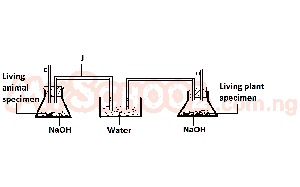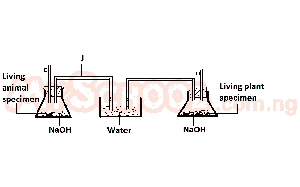Year :
1994
Title :
Biology
Exam :
JAMB Exam
Paper 1 | Objectives
11 - 20 of 50 Questions
| # | Question | Ans |
|---|---|---|
| 11. |
The failure of transport and respiratory systems in plants as well as the presence of reddish colour in stems and leaves result from the deficiency of A. magnesium B. nitrogen C. potassium D. phosphorus |
C |
| 12. |
The dental formula 13/3 c1/1 pm4/4 m2/3 is that of a A. goat B. rabbit C. man D. dog |
D |
| 13. |
The nitrifying bacteria, Nitrosomonas, convert ammonia to A. nitirites B. nitric acid C. niitrates D. nitrous oxide |
A |
| 14. |
The activity of ptyalin is likely to decrease with an increase in concentration of A. oxygen B. starch C. protein D. acid |
D |
| 15. |
The phloem parenchyma is sometimes used for A. food storage B. supporting the stem C. production of the sieve tube D. transporting water |
A |
| 16. |
The process by which a red blood cell placed in distilled water absorbs water until it burst and releases its contents into the surrounding is known as A. osmosis B. plasmolysis C. turgidity D. haemolysis |
D |
| 17. |
 The most appropriate title for the set up is A. quantitative measurement of respiration in plants and animals B. measurement of respiratory rates in living organisms C. comparison between photosynthesis and respiration D. comparison of respiratory rates in plants and animals |
D |
| 18. |
 The part labelled j is called A. porosimeter B. potometer C. manometer D. auxanometer |
C |
| 19. |
A circulatory system that does not allow mixing of oxygenated and de-oxygenated blood in mammalian heart is referred to as A. open B. haemocoelic C. single D. closed |
D |
| 20. |
Which of the following waste products in plants is excreted through the stomata and lenticels? A. Carbondioxide B. Alkaloids C. Tannins D. Anthocyanins Detailed SolutionCarbon dioxide is a waste product of aerobic respiration in plant cells |
| 11. |
The failure of transport and respiratory systems in plants as well as the presence of reddish colour in stems and leaves result from the deficiency of A. magnesium B. nitrogen C. potassium D. phosphorus |
C |
| 12. |
The dental formula 13/3 c1/1 pm4/4 m2/3 is that of a A. goat B. rabbit C. man D. dog |
D |
| 13. |
The nitrifying bacteria, Nitrosomonas, convert ammonia to A. nitirites B. nitric acid C. niitrates D. nitrous oxide |
A |
| 14. |
The activity of ptyalin is likely to decrease with an increase in concentration of A. oxygen B. starch C. protein D. acid |
D |
| 15. |
The phloem parenchyma is sometimes used for A. food storage B. supporting the stem C. production of the sieve tube D. transporting water |
A |
| 16. |
The process by which a red blood cell placed in distilled water absorbs water until it burst and releases its contents into the surrounding is known as A. osmosis B. plasmolysis C. turgidity D. haemolysis |
D |
| 17. |
 The most appropriate title for the set up is A. quantitative measurement of respiration in plants and animals B. measurement of respiratory rates in living organisms C. comparison between photosynthesis and respiration D. comparison of respiratory rates in plants and animals |
D |
| 18. |
 The part labelled j is called A. porosimeter B. potometer C. manometer D. auxanometer |
C |
| 19. |
A circulatory system that does not allow mixing of oxygenated and de-oxygenated blood in mammalian heart is referred to as A. open B. haemocoelic C. single D. closed |
D |
| 20. |
Which of the following waste products in plants is excreted through the stomata and lenticels? A. Carbondioxide B. Alkaloids C. Tannins D. Anthocyanins Detailed SolutionCarbon dioxide is a waste product of aerobic respiration in plant cells |